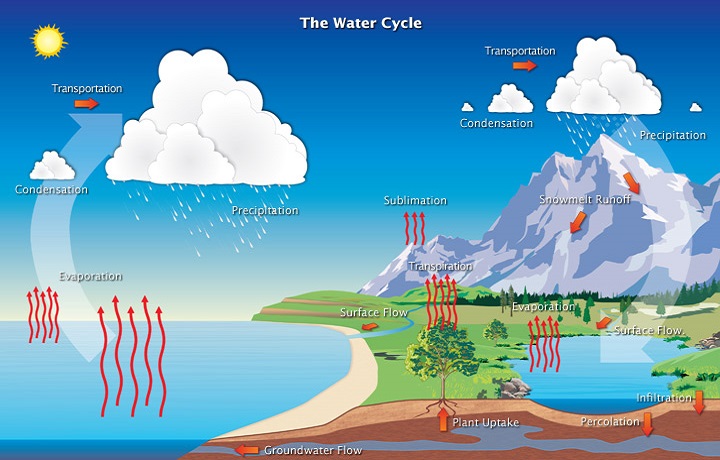- In this article, we will learn about the hydrologic cycle.
- The hydrologic cycle is known as the water cycle.
Table of Contents
Hydrologic Cycle:
The water is evaporated from the hydrosphere, land surfaces to the atmosphere, which is then condensed to the surface of the earth in different forms of precipitation. This evaporation and precipitation is a cyclic process and continues forever, and thereby, a balance is maintained between the two. This cyclic process is known as the hydrologic cycle.

What plays an important role in the completion of the hydrologic cycle?
The Sun and Coriolis forces play an important role in the completion of the hydrologic cycle. Sun imparts energy for the movement of the cycle, due to which the water in the hydrosphere evaporates into the atmosphere which is then controlled by Coriolis force in circulating the evaporated water vapor and thus, helping in its reprecipitation at different places.
What are the components of the hydrologic cycle?
The major components of the hydrologic cycle are evaporation, precipitation (rainfall, snowfall, hail, sleet, fog, dew, drizzle, etc.), interception, depression storage, transpiration, infiltration, percolation, moisture storage in the unsaturated zone, and runoff (surface runoff, interflow, and baseflow).
Importance of Hydrologic Cycle:
The hydrologic cycle is important to all life on earth for many reasons. It describes how water moves through the planet. It is important because it is how water reaches plants, animals, and human beings. Evaporation of water takes place from the oceans and land surfaces due to the energy of the sun. Plants wouldn’t grow without rain and thus anything consuming the plants wouldn’t live and so forth. Infiltration of water filters and cleans out water. Glaciers, ice, and snow can act as supplies of fresh water for both humans and other creatures. Runoff contributes to rivers, other freshwater bodies, and finally the ocean, supporting freshwater and marine life. All these processes sustain life and create the ecosystem around us.
Effect of Human Actions and Land-use Changes on Hydrologic Cycle:
Several human activities can impact the hydrologic cycle. Such as;
- Damming rivers for electricity.
- Deforestation/removal of forest cover.
- Burning of fossil fuels.
- Changes in the ability of soil to soak up water through increasing impervious surfaces, like roads and buildings.
- Filling of depressional wetlands.
- Altering stream flow and beds.
Conclusion:
In the water cycle, water transfers from one place to another place in different forms. Water moves above and below the surface of the Earth.
I hope you understand the water cycle. If you have any confusion please ask questions.
Read More Articles:
